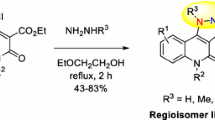Abstract
In contrast to triarylformazans, 1,3-diaryl-5-(3-chloro-2-quinoxalyl)formazans are unstable in ordinary organic solvents. When they are heated in chloroform, they undergo acidic cleavage, which leads to the formation of 3-chloro-2-quinoxalylhydrazones of p-substituted benzaldehydes and arenediazonium cations. These compounds, as a result of a redox reaction with the participation of the solvent, are converted to 4-chloro-1-(4-Y-phenyl)-1,2,4-triazolo[4,3-a]quinoxalines, substituted benzenes, nitrogen, and hydrogen chloride. The formation of the latter transforms the entire decomposition process into an autocatalytic process. Effects of chemical polarization of the nuclei (CPN), which unambiguously indicate the intermediate formation of diazoaryl radicals during the process, are observed in the PMR spectra of the final products. Such CPN effects, which were also observed in dimethyl sulfoxide (DMSO) and glacial acetic acid, indicate a process involving the oxidative formation of annelated triazoles from α-azahetarylhydrazones via a radical pathway within a solvent “cage.”
Similar content being viewed by others
Literature cited
A. V. Kessenikh, L. V. Shmelev, M. N. Stopnikova, and R. V. Poponova, Summaries of Papers Presented at the 3rd All-Union Conference on the Polarization of Electrons and Nuclei and Magnetic Effects in Chemical Reactions [in Russian], Novosibirsk (1981), p. 74.
Yu. A. Sedov, A. I. Zabolot-skaya, and N. V. Koba, Khim. Geterotsikl. Soedin., No. 12, 1705 (1973).
N. P. Bednyagina, I. Ya. Postovskii, A. D. Garnovskii, and O. A. Osipov, Usp. Khim., 44, 1052 (1975).
Yu. A. Sedov, N. N. Shumova, and N. I. Gogoleva, Khim. Geterotsikl. Soedin., No. 5, 709 (1976).
Yu. A. Sedov and M. A. Chernova, Khim., Geterotsikl. Soedin., No. 4, 545 (1978).
B. I. Buzykin, N. N. Bystrykh, and Yu. P. Kitaev, Zh. Org. Khim., 11, 1570 (1975).
B. I. Buzykin, L. P. Sysoeva, and Yu. P. Kitaev, Zh. Org. Khim., 10, 2200 (1974).
N. P. Bednyagina, E. S. Karavaeva, G. N. Lipunova, L. I. Medvedeva, and B. I. Buzykin, Khim. Geterotsikl. Soedin., No. 9, 1268 (1977).
A. F. Levit, T. G. Sterleva, L. A. Kiprianova, and I. P. Gragerov, Teor. Eksp. Khim., 10, 487 (1974).
L. A. Rykova, L. A. Kiprianova, A. F. Levit, and I. P. Gragerov, Teor. Eksp. Khim., 14, 256 (1978).
A. V. Ignatenko, S. V. Rykov, and A. V. Kessenikh, Izv. Akad. Nauk SSSR, Ser. Khim., No. 9, 2022 (1974).
R. Kaptein, J. Chem. Soc., Chem. Commun., 732 (1971).
A. R. Forester, J. M. Hay, and R. N. Thomson, The Organic Chemistry of Stable Free Radicals, London-New York (1968), p. 248.
H. Fischer and M. Lehnig, J. Phys. Chem., 75, 3410 (1971).
T. Suehiro, T. Tashiro, and R. Nakausa, Chem. Lett., No. 11, 1339 (1980).
A. L. Buchachenko, The Chemical Polarization of Electrons and Nuclei [in Russian], Nauka, Moscow (1974), p. 118.
L. Z. Rol'nik, S. M. Kalashnikov, E. V. Pastushenko, S. S. Zlot-skii, and D. L. Rakhmankulov, Zh. Org. Khim., 17, 2515 (1981).
N. N. Lebedev, M. N. Manakov, and V. F. Shvets, The Theory of Technological Processes of Basic Organic and Petrochemical Synthesis [in Russian], Khimiya, Moscow (1975), pp. 267, 285.
A. P. Novikova, M. P. Kozina, D. N. Shigorin, and I. Ya. Postovskii, Zh. Obshch. Khim., 58, 934 (1968).
A. P. Zeif, G. N. Lipunova, N. P. Bednyagina, L. N. Shchegoleva, and L. I. Chernyavskii, Zh. Org. Khim., 6, 2590 (1970).
Yu. P. Kitaev and B. I. Buzykin, Hydrazones [in Russian], Nauka, Moscow (1974), p. 322.
N. M. Sergeev, NMR Spectroscopy [in Russian], Izd. Moskovsk. Gosudarstv. Univ., Moscow (1981), p. 192.
W. Ried, Angew. Chem., 64, 391 (1952).
V. M. Dziomko, M. N. Stopnikova, L. V. Shmelev, Yu. S. Ryabokobylko, G. M. Adamova, and R. V. Poponova, Khim. Geterotsikl. Soedin., No. 10, 1408 (1980).
S. A. Stekhova, V. V. Lapachev, and V. P. Mamaev, Khim. Geterotsikl. Soedin., No. 7, 994 (1981).
Author information
Authors and Affiliations
Additional information
Translated from Khimiya Geterotsiklicheskikh Soedinenii, No. 3, pp. 413–420, March, 1985.
Rights and permissions
About this article
Cite this article
Shmelev, L.V., Stopnikova, M.N., Poponova, R.V. et al. Investigation of the decomposition of 1,3-diaryl-5-(3-chloro-2-quinoxalyl)-formazans by PMR and MASS spectrometry. Chem Heterocycl Compd 21, 347–354 (1985). https://doi.org/10.1007/BF00506679
Received:
Revised:
Issue Date:
DOI: https://doi.org/10.1007/BF00506679



